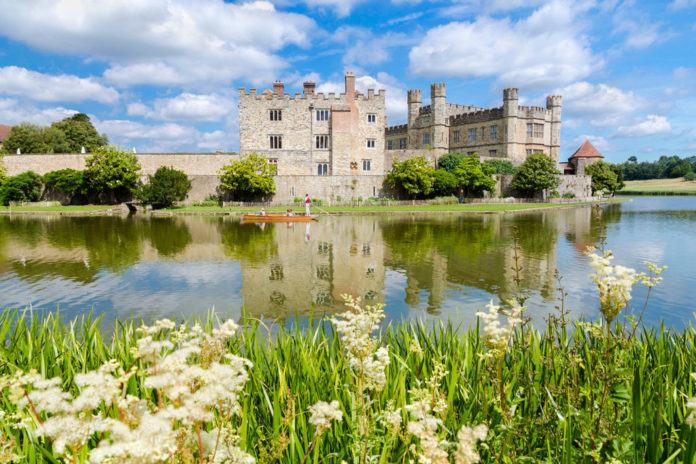Leeds Castle celebrates its 900th anniversary this year. We look back at its many incarnations, from Norman stronghold and royal palace to lavish private home.
When American newspaper tycoon Randolph Hearst decided he wanted to buy
an English castle, he sent a telegraph to his agent: “Want buy a castle in England. Please find which ones available.” Leeds Castle in Kent had just gone up for sale and his agent duly looked round, before sending back a dismal report: “Not a bath in place only lighting oil lamps and servants quarters down dungeon.” This was enough to scare off the luxury-loving Hearst, but The Hon Olive Wilson-Filmer, an Anglo-American heiress, glimpsed beauty in the decaying rooms and overgrown grounds, and snapped up the castle in 1926 for £180,000.
Decrepit it may have been, but it was a real royal castle, historic home of kings and queens, surrounded by a moat and set in 500 acres of parkland. Not only one of Britain’s most beautiful castles (it was described by historian Lord Conway as “the loveliest castle in the world” in 1913, and the epithet has stuck), Leeds is also one of its most storied.
The first stone castle here was built in 1119 on a rocky islet in the River Len by the one of the great Norman noble families, the de Crèvecoeurs. This was a castle designed to be lived in – something that appealed to the kings and queens who were to become its occupants. The first royal owner was Queen Eleanor of Castile, Edward I’s wife, who bought Leeds in 1278 when its owner ran into debt.
Edward improved the castle’s defences, constructing soaring 30-foot walls, a barbican and a bath house. The three-storey keep was transformed by Queen Eleanor into the Gloriette, with a central courtyard, a Great Hall and luxurious apartments.
Eleanor died in 1290. A grief-stricken Edward constructed the Chapel in her honour and had monks chant mass for her day and night. In 1299, to improve England’s fraught relations with the French, Edward married French princess Margaret and granted her the castle: the start of a centuries-long tradition that saw Leeds Castle forming part of the ‘dower’ – personal property to be retained after the king’s death – of several of England’s queens.
Upon Margaret’s death Leeds reverted to the Crown, but wayward Edward II didn’t follow his father’s example, granting the castle not to his queen, Isabella, but to one Batholomew of Badlesmere, Lord Steward of the royal household. Although Leeds had passed out of royal hands, when Isabella arrived at the castle in 1321 she expected the usual deferential welcome. However, she was refused access by Badlesmere’s wife, who instructed archers to fire upon her and her entourage. An incensed Edward besieged and captured the castle, imprisoning Lady Badlesmere and beheading her husband. Queen Isabella regained the castle, holding it until her death in 1327.

The castle’s queenly associations don’t end there. Richard II wisely followed tradition and bequeathed the castle to his queen, Anne of Bohemia, in 1382; as did Henry IV, who gave Leeds to his second wife Joan of Navarre; and Henry V, who gave the castle to his widow Catherine de Valois. In an evocation of Henry and Catherine’s royal apartments in the present-day castle, a magnificent bed is draped in silk damask, embroidered with the initials H and C entwined with a lovers’ knot.
For more on Leeds Castle and its royal owners, read the full article in BRITAIN Volume 87 Issue 6, on sale here.






 © 2024
© 2024